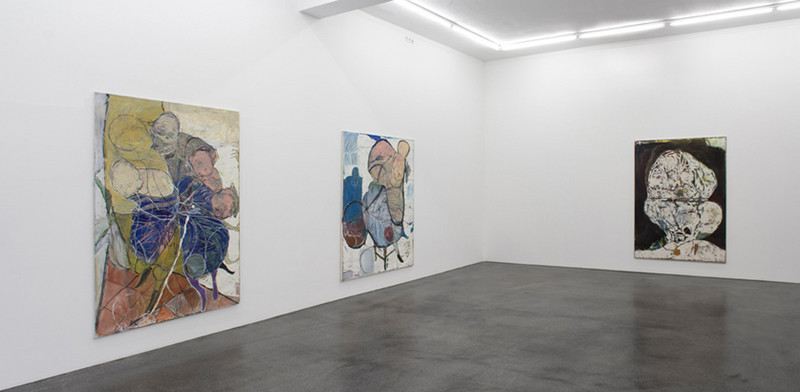Waldemar Zimbelmann
28 Feb - 11 Apr 2015
WALDEMAR ZIMBELMANN
cross eyed notion
28 February – 11 April 2015
Gallery Meyer Riegger is pleased to present Waldemar Zimbelmann’s fourth solo show, cross eyed notion.
With his new works, Waldemar Zimbelmann seeks an unusual shifting and crossing of the gaze. The cross-eyed view allows a form of perception that is simultaneously conscious and disturbed, focused yet disillusioned. To a similar effect, the usual mechanisms of perception are led astray within Zimbelmanns new paintings. Partial images, schematic silhouettes, individual heads and limbs intersect a concrete, clearly defined figure or group of figures, taking on a life of their own. From abstract lines, color surfaces, and compositional overlappings a range of figures gradually reveal themselves through the process of each painting. Some of them remain as spectral outlines, as quick sketches, while others become fixed and concrete. Gestural elements come increasingly to bear and give the works a playful lightness despite their formal power and rigor.
If in the artists last exhibition, Symbiose, the figures that fused and overlapped body parts were usually in themselves quite distinct, then in the new works many undefined bodies, faces, and limbs combine to form a compositional subject that can be decoded as either an individual figure, couple, or simply an abstract conglomeration of body parts and fragments. In this way, the face of a figure can be momentarily recognized as it dissolves into the realm of a torso while the positions of its legs and feet remain distinctly visible. Through simple silhouettes and sketch-like approaches, Zimbelmann offers the viewer ever-new routes to follow through the various limbs and bodies, to identify and compose its elements or to simply lose oneself within.
In many works, the solidity of the background gives way to elements of spatial abstraction, providing a space for these confused knots of figures to exist. Zimelmann further encourages alternative associations of space by way of a radical intervention at the end of each painting process. This inverted intervention, scratching and scraping away layers of paint down to the raw canvas, allows the viewer to recognize traces of landscapes or spaces that emerged during the painting process, and yet had disappeared in the final work. The white of the raw canvas now becomes a color of its own, creating a competition with the other shades of white. Thus, the background is in a certain sense both absent and present.
Zimebelmanns characters are figures of fantasy, products of the artist’s imagination that develop and take concrete shape through the painters pure search for form. While in some images, such as Casimir and Caroline, the open dynamic of these leaps, lunges, and gestures condenses to a single recognizable act, a wild and yet intimate dance for two, in other works the action of crossing and circling forms remains a vague suggestion, pure dynamism.
Text: Christina Pasedag
cross eyed notion
28 February – 11 April 2015
Gallery Meyer Riegger is pleased to present Waldemar Zimbelmann’s fourth solo show, cross eyed notion.
With his new works, Waldemar Zimbelmann seeks an unusual shifting and crossing of the gaze. The cross-eyed view allows a form of perception that is simultaneously conscious and disturbed, focused yet disillusioned. To a similar effect, the usual mechanisms of perception are led astray within Zimbelmanns new paintings. Partial images, schematic silhouettes, individual heads and limbs intersect a concrete, clearly defined figure or group of figures, taking on a life of their own. From abstract lines, color surfaces, and compositional overlappings a range of figures gradually reveal themselves through the process of each painting. Some of them remain as spectral outlines, as quick sketches, while others become fixed and concrete. Gestural elements come increasingly to bear and give the works a playful lightness despite their formal power and rigor.
If in the artists last exhibition, Symbiose, the figures that fused and overlapped body parts were usually in themselves quite distinct, then in the new works many undefined bodies, faces, and limbs combine to form a compositional subject that can be decoded as either an individual figure, couple, or simply an abstract conglomeration of body parts and fragments. In this way, the face of a figure can be momentarily recognized as it dissolves into the realm of a torso while the positions of its legs and feet remain distinctly visible. Through simple silhouettes and sketch-like approaches, Zimbelmann offers the viewer ever-new routes to follow through the various limbs and bodies, to identify and compose its elements or to simply lose oneself within.
In many works, the solidity of the background gives way to elements of spatial abstraction, providing a space for these confused knots of figures to exist. Zimelmann further encourages alternative associations of space by way of a radical intervention at the end of each painting process. This inverted intervention, scratching and scraping away layers of paint down to the raw canvas, allows the viewer to recognize traces of landscapes or spaces that emerged during the painting process, and yet had disappeared in the final work. The white of the raw canvas now becomes a color of its own, creating a competition with the other shades of white. Thus, the background is in a certain sense both absent and present.
Zimebelmanns characters are figures of fantasy, products of the artist’s imagination that develop and take concrete shape through the painters pure search for form. While in some images, such as Casimir and Caroline, the open dynamic of these leaps, lunges, and gestures condenses to a single recognizable act, a wild and yet intimate dance for two, in other works the action of crossing and circling forms remains a vague suggestion, pure dynamism.
Text: Christina Pasedag

